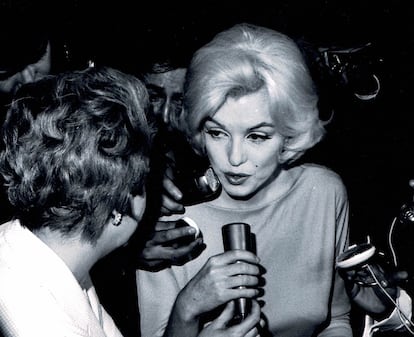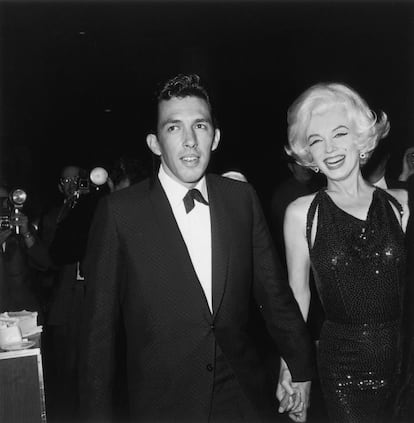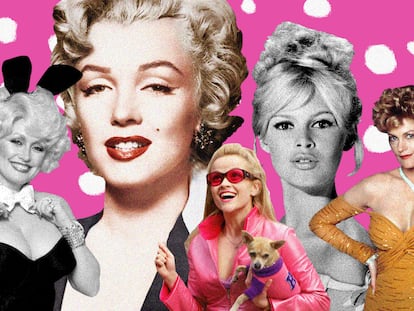Marilyn Monroe in Mexico: When the Hollywood star ate, drank and fell in love
Sixty years ago, the actress visited Mexico to relax, expedite divorce proceedings and buy furniture for her house, all while under FBI surveillance for hobnobbing with communists

On February 22, 1962, a 23-year-old freelance photographer received an enviable assignment in Mexico City. The most beautiful woman in the world, and one of the most famous actresses and singers of her time, was going to be in town. He was assigned to photograph Marilyn Monroe and preserve her trip for posterity. The photographer, Antonio Caballero, was excited to go to the Continental Hilton Hotel. Dozens of reporters and photographers were waiting there for Monroe. They asked her why she wasn’t wearing stockings, to which she replied: “Don’t you like my skin?” Then, they asked her if she wore underwear, and she said she “only wore Chanel Number 5,″ recalls Caballero, who will turn 83 soon. Six decades ago, the acclaimed Hollywood star bought furniture for the house where her body was found, acquired the sweater that she wore in one of her last photo shoots, and had a love affair with Mexican filmmaker José Bolaños, all while the FBI has her under surveillance, five months before her death.
Monroe was no stranger to Mexico. Beyond the fact that her mother was born in Piedras Negras (Coahuila), the actress had vacationed with her boyfriend and future husband, baseball player Joe DiMaggio, on the beaches of Puerto Peñasco, in Sonora in 1953. Eight years later, she returned to Mexico to go to Ciudad Juárez to get a quick divorce from Arthur Miller, according to the 1961 records from Chihuahua’s legal archives. But her last trip to Mexico on February 20, 1962, generated the most media attention and was the most widely documented.
Caballero recalls the stress among the photographers waiting for her when she was almost two hours late for her press conference. “She did not arrive. It was 3pm, 3.30pm, 3.45pm, we were already saying that we were going to leave when she appeared in another elevator and was surrounded by a swarm of photographers with their flashes,” he says. The actress had actually landed in Mexico two nights before. She was traveling with her hairstylist, her press officer, and her assistant Eunice Murray, according to her biographer Alberto Cabot, the author of the book Marilyn in Mexico, which will be released in early 2023. The purpose of the trip was to buy furniture for the Spanish-style house she had purchased a month earlier, the same house that appears in forensic photographs from the day after her death. “That’s why you can see in the photos that her house is almost empty; most of the purchases she made in Mexico hadn’t arrived yet,” Cabot explains.
¿Puedes identificar en que lugar de Puerto Peñasco está Marilyn Monroe?
— Puerto Peñasco (@visitapenasco) July 24, 2018
¡Así es! Ella visitó Puerto Peñasco junto con Joe DiMaggio en julio del 1953
Lee el artículo completo en:https://t.co/n5sdKqlh6H pic.twitter.com/hKfRk8MDir
The intersection of Reforma and Insurgentes streets, where the imposing Federal Electricity Commission building stands today, used to be the site of the Hilton Continental Hotel, which had to be demolished after the 1985 earthquake. Jean Pierre Piquet was the hotel manager. He was a friend of Frank Sinatra’s, and the singer tasked him with treating Monroe like a queen. From her conference room, the actress delighted the press by blowing kisses with her hand, and she continued to smile throughout. Even when reporters asked her measurements, if she had become bitter about her failed marriages, and if she would like to have a fling with a Mexican actor, Monroe was unfazed. “I never measure myself, it’s [other] people who measure me”; “No way, I still haven’t given up hope that I’ll find happiness” and “Why does he have to be an actor? Just being Mexican is enough for me,” she replied kindly, in a melodious and calm tone of voice, in Caballero’s words. “She was wearing a light aqua green three-quarter-sleeve dress,” he recalls. It was the same outfit Monroe would be buried in just five months later.
Like the rest of the photographers, Caballero jostled for a good angle from which to take a picture. He ended up at the feet of the star, who was sitting in an armchair with her legs crossed in front of a bottle of champagne. “Just as she poured herself a glass and uncrossed her legs, I took a picture of her. I realized when I developed [the photograph] that she wasn’t wearing underwear. I felt ashamed, we had been raised with modesty and respect for women,” says Caballero, whose iconic photo was nonetheless copied many times.

The actress had a busy schedule that day. After her press conference, she went to Mexico City’s Centro Histórico (Historic Center) to eat at El Taquito, the famed restaurant that opened in 1917. It continues to operate to this day, although the years have buried it among countless street vendors. Its orange walls are lined with hundreds of photographs of its famous diners. The most sought-after photo is the one showing the star of Gentlemen Prefer Blondes (1953); in it, she sits with a margarita in her hand next to the restaurant’s smiling owner, Rafael Guillén. His 60-year-old son, who has the same name, leads the way to Monroe’s photograph. He stands next to a window that lets in a ray of sunlight, illuminating a chair. “This is where she sat, right here,” Guillén points out.
His late father told him the story of Monroe’s visit hundreds of times. “The city’s mayor [Ernesto Peralta Uruchurtu] called him to let him know that someone important was coming, but he didn’t say who,” Guillén recounts. Marilyn Monroe appeared shortly thereafter and “stopped traffic,” according to contemporary newspapers. “Buenas tardes,” Monroe said in her limited Spanish. Guillén Sr. served her tequilas and margaritas nonstop. He also gave her maguey worm tacos, before asking her to dance. “My father was the man who asked the most beautiful woman in the world to dance,” his son says proudly. Mariachis and a trio played a good selection of music, including Cielito lindo and La malagueña, songs that the actress sang to the delight of those in the restaurant.
More than three hours and several drinks later, Monroe left El Taquito to go to actor and director Emilio “El Indio” Fernández’s house. The American actress, who had been drinking since the press conference, only had a couple more drinks with him and his wife, Columba Domínguez. She left a few minutes later to arrive on time for her last appointment of the night, a more intimate encounter with José “Pepe” Bolaños, a young Mexican filmmakerwho moved in leftist circles.

Frederick Vanderbilt - a descendent of the wealthy US railroad-building family, who was disinherited because of his leftist ideas - had the assignment of acting as Monroe’s host in Mexico at the request of a mutual friend. He knew that the FBI was watching Monroe because of her relationships with communist sympathizers following her marriage to Arthur Miller and warned her that meeting with Bolaños in public was not a good idea. In the FBI’s declassified Monroe surveillance files, agents noted that during her vacation in Mexico, the actress “associated directly with certain members of the Group of Communist Americans in Mexico.”
Vanderbilt and his wife Nieves Orozco - painter Diego Rivera’s former model - were careful not to be photographed with Monroe, and Bolaños did the same. Carbot describes the Mexican filmmaker as a man who conquered some of the most beautiful women of his day, including Gina Lollobrigida and Elsa Aguirre. Carbot says that the latter confessed to him that even though Bolaños was neither attractive nor an important name in the industry, he was a man who “knew how to make you feel like the only woman in the world.” The Mexican was at the hotel in Las Mañanitas restaurant when Monroe was returning to her room; he took her to Garibaldi, according to the biographer’s records.
In the days that followed, the Vanderbilts and Monroe went on trips to Toluca, the State of Mexico and Taxco. Bolaños followed her there with a group of mariachis to serenade her at the hotel. On that trip, Monroe bought some furniture as well as the famous white sweater she wore when she was photographed for the last time by George Barris in July 1962 at Santa Monica Beach. The same sweater that Monroe purchased from a market in the State of Toluca was auctioned by Christie’s for $167,000.

Upon returning to the capital, Monroe went to visit the country’s most important film set, Churubusco Studios. Her arrival coincided with the filming of The Exterminating Angel (1962), directed by Luis Buñuel, who was in the middle of work when the actress appeared. In an interview for EL PAÍS in 2016, the actress who starred in the film, Silvia Pinal, said that she and the other actors were covered in honey and mud to shoot the scenes, so she preferred not to introduce herself to the Hollywood actress who had “arrived like a princess” to meet Buñuel. “He went crazy over Marilyn fucking Monroe. She arrived naked with a little dress on top. When she arrived, all the gentlemen were drooling. I ran away. I didn’t want to be seen with her,” Pinal said; the two actresses were never in the same room.
Monroe’s film advisor in Germany, Peter Schnug, says that when she talked to Buñuel, they discussed the possibility of making films together in Mexico. Monroe had her own production company and wanted to take on projects abroad. “She was in the [movie] industry, but she wanted to get out of Hollywood. She thought those films were stupid,” says Schnug. He adds that there was a sense that the golden age of cinema in the United States was coming to an end, and Monroe greatly admired Buñuel’s work.

On March 3, Monroe returned to Los Angeles in time to take Bolaños to the Golden Globes. Five months later, she was found dead in her nearly empty bedroom, a space she intended to fill with the handcrafted pieces of furniture she purchased in Taxco, which remained in storage. Shortly after her death, Bolaños was photographed taking flowers to her grave. “I’ve never found a woman like her, to this day. She liked children and wanted [to have] one with me, with a Mexican,” he said in interviews before his death. Cabot adds that the actress’s inner circle say that the 10 days she spent in Mexico were among the happiest of her life.
Tu suscripción se está usando en otro dispositivo
¿Quieres añadir otro usuario a tu suscripción?
Si continúas leyendo en este dispositivo, no se podrá leer en el otro.
FlechaTu suscripción se está usando en otro dispositivo y solo puedes acceder a EL PAÍS desde un dispositivo a la vez.
Si quieres compartir tu cuenta, cambia tu suscripción a la modalidad Premium, así podrás añadir otro usuario. Cada uno accederá con su propia cuenta de email, lo que os permitirá personalizar vuestra experiencia en EL PAÍS.
¿Tienes una suscripción de empresa? Accede aquí para contratar más cuentas.
En el caso de no saber quién está usando tu cuenta, te recomendamos cambiar tu contraseña aquí.
Si decides continuar compartiendo tu cuenta, este mensaje se mostrará en tu dispositivo y en el de la otra persona que está usando tu cuenta de forma indefinida, afectando a tu experiencia de lectura. Puedes consultar aquí los términos y condiciones de la suscripción digital.
More information
Últimas noticias
Trump claims peace in Ukraine is near, but Moscow suggests otherwise
A survivor’s account of the Interoceanic Train accident: ‘We were scared because of the speed on the curve’
The Interoceanic Train, the Mexican alternative to the Panama Canal
What is known about the Interoceanic Train derailment in Oaxaca
Most viewed
- Oona Chaplin: ‘I told James Cameron that I was living in a treehouse and starting a permaculture project with a friend’
- Reinhard Genzel, Nobel laureate in physics: ‘One-minute videos will never give you the truth’
- Why the price of coffee has skyrocketed: from Brazilian plantations to specialty coffee houses
- Pablo Escobar’s hippos: A serious environmental problem, 40 years on
- Chevy Chase, the beloved comedian who was a monster off camera: ‘Not everyone hated him, just the people who’ve worked with him’











































